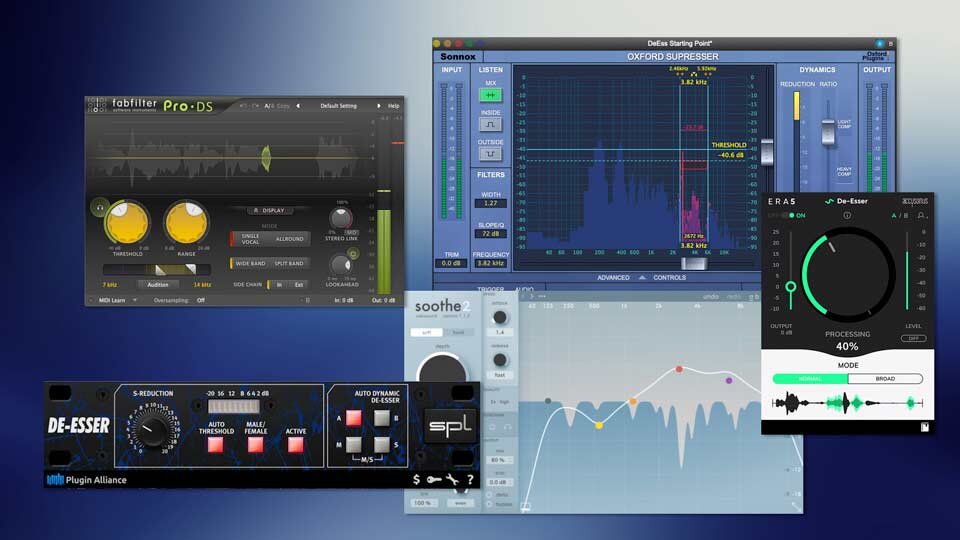What is a De-Esser?
In the intricate world of audio mixing, there are tools aplenty to sculpt sound. The De-Esser is one such tool but it’s often overlooked and its powers underestimated. Used well, a de-esser can elevate your vocal audio production to new heights. In this comprehensive guide, we’ll explore the world of de-essing, its role in audio production, and how to wield it effectively.
Sibilance explained
Sibilance, characterized by its bright and high-amplitude qualities, is the product of specific consonants, mainly the ‘s’ and ‘sh’ (although other sounds such as ‘t,’ ‘d,’ and ‘z can cause issues). These are commonly referred to in audio engineering circles as”esses.” These ”esses’ often manifest during speech, rap, or song performances. The intensity of sibilance in a recording can be attributed to various factors. These include microphone selection, EQ adjustments that enhance the upper frequencies, or the inherent sound of esses produced by a vocalist. De-essing comes to the rescue by targeting and taming these troublesome sibilant frequencies, ensuring your vocals are smooth and easy on the ears.

How De-Essers Work to Reduce Sibilance
De-essers are a type of audio processor, operating much like a compressor. They specialise in identifying and attenuating high-frequency peaks or ‘esses’ in your audio signal. Focusing specifically on these sibilant frequencies, they reduce their volume, effectively minimising any harshness.
De-Esser Parameters
To use a de-esser effectively, it’s essential to understand its key parameters:
- Frequency Range: Specifies the frequency band that the de-esser targets.
- Threshold: Determines when the de-esser activates, based on the amplitude of sibilant frequencies.
- Ratio: Controls the degree of gain reduction applied to sibilant frequencies.
- Attack and Release: Adjust the speed at which the de-esser reacts to sibilance and recovers after attenuation.
De-Essing – Good Practice
Achieving clean natural-sounding de-essing involves setting appropriate parameters and careful listening. It is important to not Over-process as this can take the life out of a vocal. Too much de-essing can even make a vocalist sound as though they have a lisp.
The trick is to spend some time homing in on the specific problem frequency. You can use your ears to do this or there are tools available that can help do this for you. Then use the de-esser to gently dial down this frequency. If you can hear the de esser working then you have probably set the threshold too low. Subtlety is the key here. You just want to remove the harshness whilst retaining the natural character of the vocals ‘esses.
Inevitably some esses (i.e different consonants) will be more pronounced and problematic than others. You may therefore want to apply different de-esser settings throughout the vocal performance. This can be done by automation or by isolating certain problem words and processing accordingly with a separate de-esser.
Handcrafted De-Essing
While most people use plugins to handle their de-essing, some will choose to go in and remove the ‘esses’ manually. Using your ears to detect any harsh esses, use your slice tool to isolate the offending consonant. Then reduce the gain on the offending sound, again using your ears as a guide. While this technique is more time-consuming it does offer an added level of control over the entirety of a vocal.
Using a De-Esser in a Vocal Chain
It’s important to consider where you place your de esser in a vocal chain. Although there is some debate, most engineers agree its good practise to place a de-esser before the vocal compressor. This is because you want the de esser to process and attack a vocal with all the peaks intact and unaffected.
On the other hand, it’s generally recommended to apply any EQing or exciting before the de esser. This is because you may end up re-adding harsh sibilance with any subsequent EQ boosting.
As a rule, your vocal chain should therefore look like this: EQ – De-Esser -Compressor.
Other Uses for a De-Esser

While de-essing is widely considered to be the preserve of vocals it can however be used to treat any harsh problem frequencies. Distortion on Electric guitars can often introduce harshness in the midrange as well as a high-frequency electrical buzz. It might be worth reaching for the de esser opposed to EQ to treat such issues. De-essing may also help If you’re sampling from old vintage sources as harsh tones are often inherent in these recordings.
Another application that doesn’t often get mentioned is the use of de-essing in Mastering. Top mastering engineers will often apply de-essers to tame certain troublesome frequencies in a mix.
Conclusion
Of all the tools available in the mixing toolbox, de-essing is often the unsung hero that deserves recognition. Most engineers agree that a great vocal is the key to a great mix. Removing any overpowering sibilance with a de-esser is a crucial part of creating a polished vocal. And as we have learnt the de-esser can be used for so much more. So why don’t you see what it can do for the sound of your next production?
Remember – RouteNote Create subscriptions start from as little as $2.99. You also get 10 FREE credits to spend on samples along with access to our FREE sample pack bundle when you sign-up!
